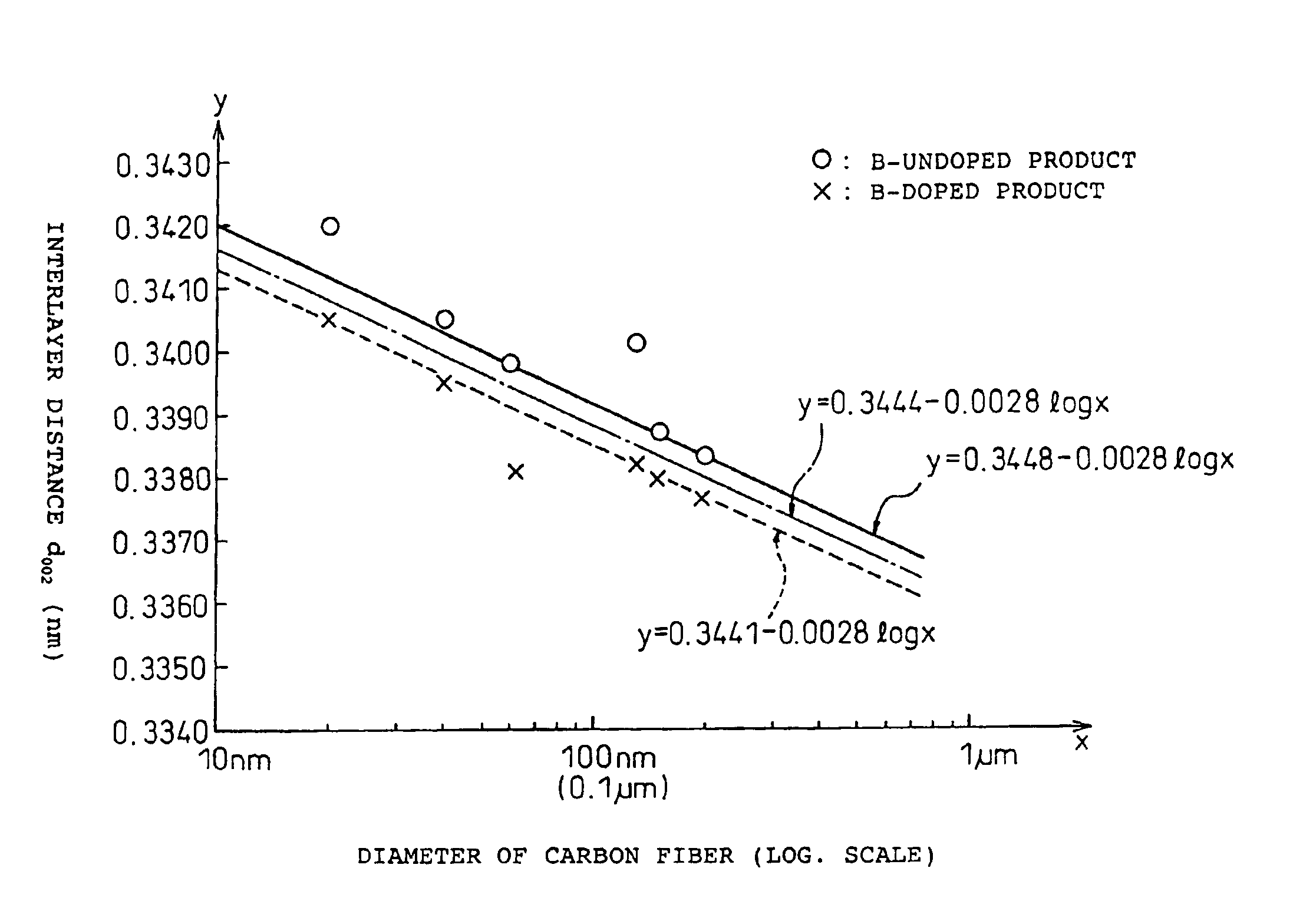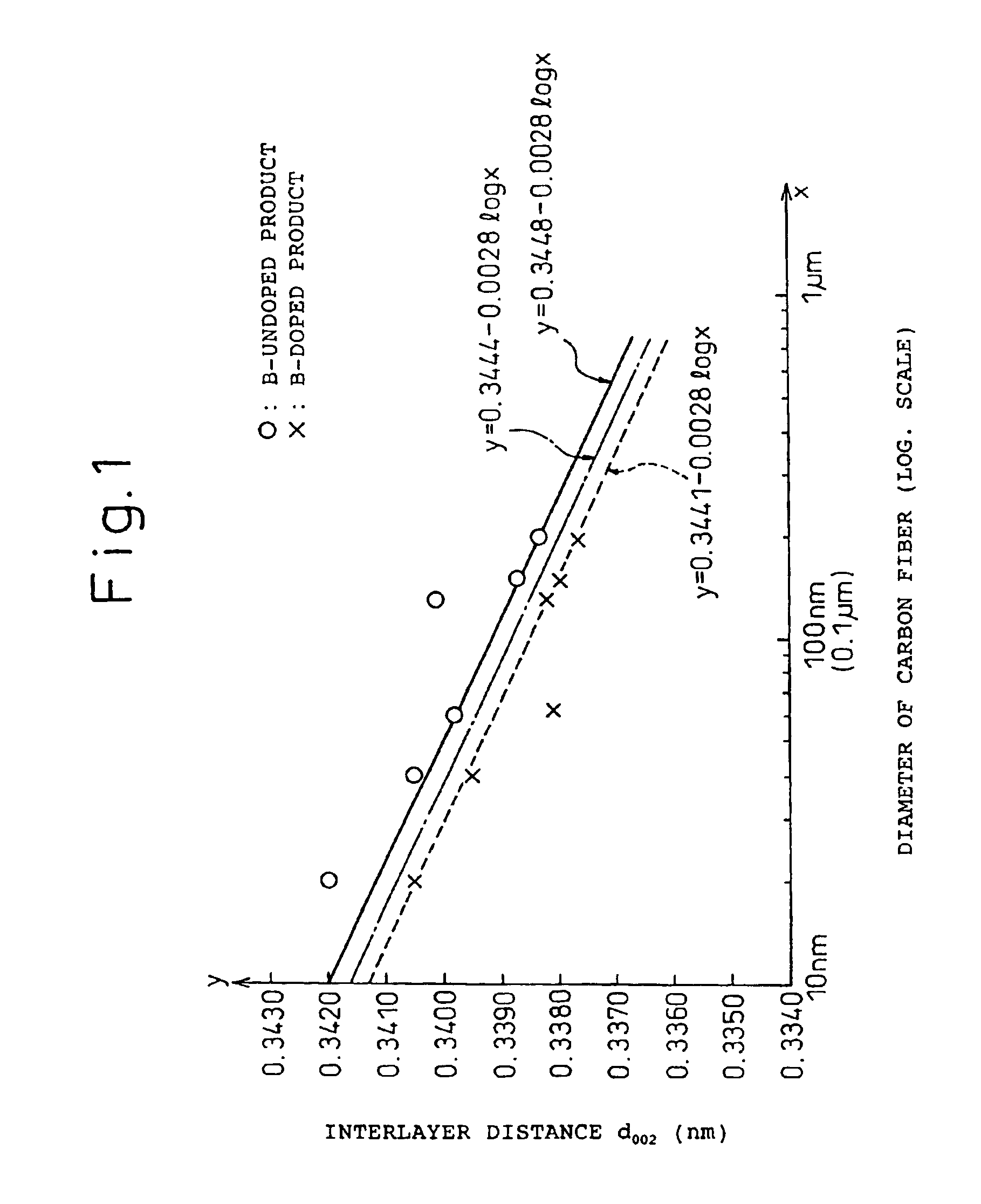Carbon fibers, production process therefor and electrode for batteries
a carbon fiber and production process technology, applied in the field can solve the problems of not being able to control the characteristics of fine carbon fibers having a fiber diameter of 1 m, the degree of enhancement of crystallinity and characteristics of fine carbon fibers having such a particular crystal structure by using a graphitization catalyst, etc., and achieves high crystallinity and high crystallinity. , the effect of high crystallinity
- Summary
- Abstract
- Description
- Claims
- Application Information
AI Technical Summary
Benefits of technology
Problems solved by technology
Method used
Image
Examples
example 1
[0101]Carbon fibers obtained through a known method (e.g., a method disclosed in Japanese Patent Application Laid-Open (kokai) No. 7-150419) in which benzene is thermally decomposed in the presence of an organic compound containing a transition metal was used as a raw material, which was subjected to a heat treatment at 1200° C. The resultant flocculated fibers were disintegrated, to thereby produce carbon fibers having a bulk density of 0.02 g / cm3 and a fiber length of 10-100 μm. Most of the fiber filaments had a fiber diameter of 0.5 μm or less (average fiber diameter obtained through observation by use of an SEM image is 0.1 to 0.2 μm). X-ray diffraction analysis revealed that the fibers had an interlayer distance between crystal layers represented by d002 of 0.3407 nm and Lc of 5.6 nm.
[0102]The thus-produced fibers (2.88 kg) and B4C powder (average particle size of 15 μm, 120 g) were sufficiently mixed by use of a Henschel mixer. The mixture was fed in a 50-L pipe-shaped graphit...
example 2
[0105]Carbon fibers obtained in a similar manner as described in Example 1 was disintegrated and crushed, to thereby produce carbon fibers having a bulk density of 0.05 g / cm3. Most of the fiber filaments had a fiber length of 10-50 μm and a fiber diameter of average fiber diameter of 0.06 μm obtained through observation by use of an SEM image. The thus-produced fibers (150 g) and B4C powder (average particle size of 10 μm, 6 g) were sufficiently mixed by use of a Henschel mixer. The mixture was fed in a cylindrical molding apparatus and pressed, to thereby obtain a column formed of carbon fiber having a diameter of 150 mm and a bulk density of 0.087 g / cm3.
[0106]The shaped fibers were heated at 2800° C. under an argon flow for 60 minutes in a graphite furnace having a heating medium made of graphite.
[0107]After completion of heat treatment, the fibers were removed from the furnace, simply disintegrated to a dimension of 2 mm or less by use of a mortar, crushed by use of a bantam mill...
example 3
[0109]Fine carbon fibers used as a raw material were obtained through the same known method disclosed in Japanese Patent Application Laid-Open (kokai) No. 7-150419 in which benzene is thermally decomposed in the presence of an organic compound containing a transition metal. The carbon fibers, which were not subjected to a heat treatment, were disintegrated to a bulk density of 0.01 g / cm3. Most of the fiber filaments had a fiber diameter of 0.13 μm or less. The thus-produced fibers (200g) and B4C powder (average particle size of 19 μm, 8 g) were sufficiently mixed by use of a Henschel mixer. The mixture was fed in a shaping machine and pressed to form a cylinder having a diameter of 150 mm. The bulk density after the shaping was 0.07 g / cm3.
[0110]The shaped body was placed in a graphite furnace with a graphite heater and was subjected to a heat treatment at 2800° C. for 60 minutes.
[0111]After the heating, the shaped body was removed, disintegrated to a diameter of 2 mm or less by use ...
PUM
| Property | Measurement | Unit |
|---|---|---|
| Temperature | aaaaa | aaaaa |
| Length | aaaaa | aaaaa |
| Percent by mass | aaaaa | aaaaa |
Abstract
Description
Claims
Application Information
 Login to View More
Login to View More - R&D
- Intellectual Property
- Life Sciences
- Materials
- Tech Scout
- Unparalleled Data Quality
- Higher Quality Content
- 60% Fewer Hallucinations
Browse by: Latest US Patents, China's latest patents, Technical Efficacy Thesaurus, Application Domain, Technology Topic, Popular Technical Reports.
© 2025 PatSnap. All rights reserved.Legal|Privacy policy|Modern Slavery Act Transparency Statement|Sitemap|About US| Contact US: help@patsnap.com



